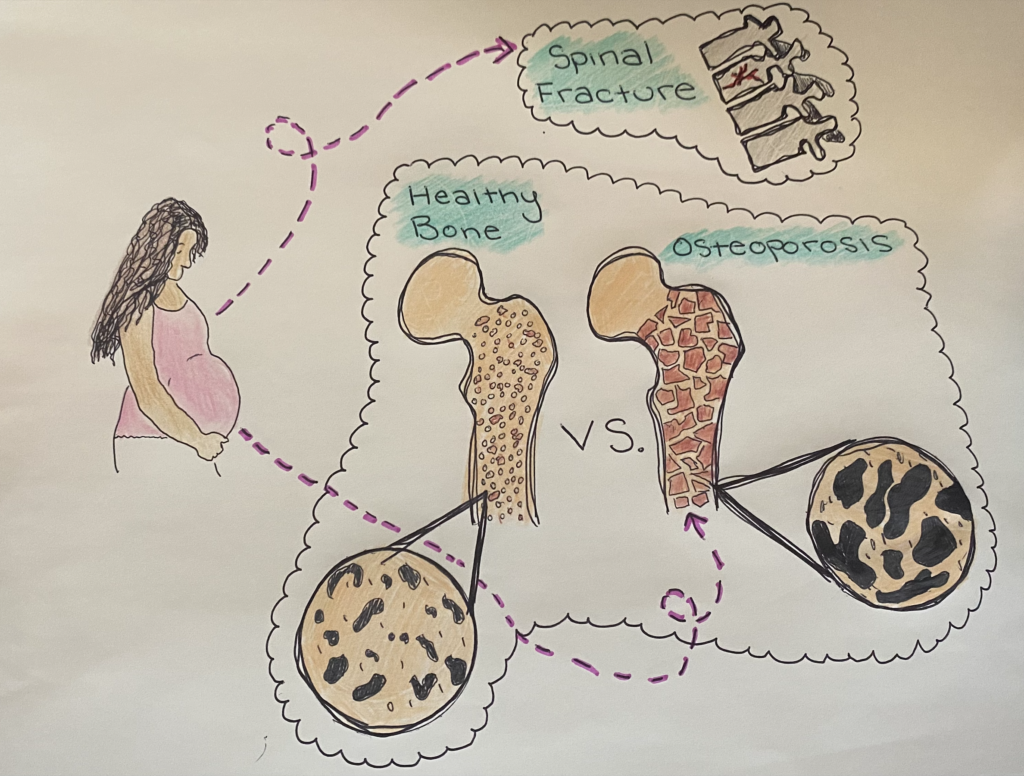
Osteoporosis is a condition in which a loss of tissue causes bones to become weak, and brittle. It is usually due to a change in hormones, or a lack of certain nutrients. The development of osteoporosis can be linked to aging, a lack of physical activity, menopause, and more. However, a small percent of women who undergo childbirth also develop osteoporosis. While pregnant, the fetus needs calcium to grow, and it causes a loss of calcium in the mother. This is common during pregnancy, and causes a loss in bone density. Breastfeeding also contributes to the loss of calcium. While pregnant, and breastfeeding, women lose calcium, and bone mass, but usually recovers, and gradually gets back to normal levels. Pregnancy-related osteoporosis is not super common, however, it can still affect many women.
This pregnancy-associated osteoporosis is usually found after the woman gives birth, and is experiencing severe back pains. It affects the bones in the hips, and throughout the spine. There are usually fractures to the vertebrae. These fractures usually take place around the third trimester, or even after delivery. This is because during the third trimester calcium mobilization and bone resorption increases, and only further increase during lactation. When diagnosing osteoporosis after pregnancy, there are a few imaging studies that are used. For example, an MRI, CT scan, and bone biopsy are helpful in recognizing and diagnosing osteoporosis.
The development of osteoporosis while pregnant is usually aided by a few other causes. This includes family history, Crohn’s disease, and the use of blood thinners. When someone is already lacking calcium, or vitamin D, and then goes through a pregnancy, the risk of osteoporosis will be significantly higher. Other presumed risk factors of pregnancy-related osteoporosis are preterm labor or pregnancy-induced hypertension.
Postpartum osteoporosis can be treated, causing bone density to increase, and a relief of back pain. Having a rich calcium diet, taking calcium supplements, staying active, and weaning breastfeeding are some of the smaller things that can be done to treat osteoporosis. Medication is also an option, and there are a few different options that help with bone density.
Another thing that could help with pregnancy-related osteoporosis is taking preventative measures. Bone mineral density can be tested, however, it usually isn’t before a pregnancy. Testing bone mineral density before a pregnancy could be really helpful, and give the mother and doctor time to try and avoid fracturing. This could include taking more calcium, or vitamin D. It could also help those who have a family history of osteoporotic fractures. BY regularly taking vitamin D, and creating a diet that is high in the proper nutrients, it can help with the absorption of calcium, and lower the risk of developing osteoporosis.
Once treated, however, there is still a risk of recurrence of pregnancy-related osteoporosis. In future pregnancies, women who experienced pregnancy-related osteoporosis are at risk of developing it again. It was even found that the rate of fracture recurrence was around 33%. Even though the chances of pregnancy-related osteoporosis are low, if a woman is experiencing fractures, and a higher rate of refractures, it is a major concern.
Carrie Madormo, RN. “Pregnancy and Osteoporosis.” Verywell Health, 9 Feb. 2023, www.verywellhealth.com/pregnancy-induced-osteoporosis-6944855.
“Rare Form of Osteoporosis around Pregnancy Gets Spotlight at Columbia.” Columbia University Irving Medical Center, 10 July 2019, www.cuimc.columbia.edu/news/rare-form-osteoporosis-around-pregnancy-gets-spotlight-columbia.
Wang, Li-Ting et al. “Hormone-Related and Drug-Induced Osteoporosis: A Cellular and Molecular Overview.” International journal of molecular sciences vol. 24,6 5814. 18 Mar. 2023, doi:10.3390/ijms24065814
Yun, Ka Yeong et al. “Pregnancy-related osteoporosis and spinal fractures.” Obstetrics & gynecology science vol. 60,1 (2017): 133-137. doi:10.5468/ogs.2017.60.1.133

Emma Seward covered pregnancy-related Osteoporosis as it affects a small percentage of women while undergoing childbirth. As Emma explains in her project, during childbirth, the fetus needs calcium to grow, and this can cause a decrease in calcium in the mother. Mothers in childbirth and while breastfeeding can lose calcium and bone mass.
As Emma Seward discusses, pregnancy-related osteoporosis is typically found in women after they give birth. There are several things that can contribute to the onset of osteoporosis in pregnancy, which can include Crohn’s Disease, family history, the use of blood thinners, vitamin D deficiency, or someone already deficient with calcium.
Postpartum and pregnancy-related osteoporosis can be treated with a rich calcium diet, supplements, an active lifestyle, or weaning breastfeeding. Medication can also be prescribed.
Once treated, there is still a risk of recurrence in future pregnancies, and women who experience pregnancy-related osteoporosis are at risk of developing it again.